
(MO)TION
Saturday, October 27th to Sunday, December 9th. 10am till 6pm. Open throughout the exhibition, Admission free
Jolene MOK
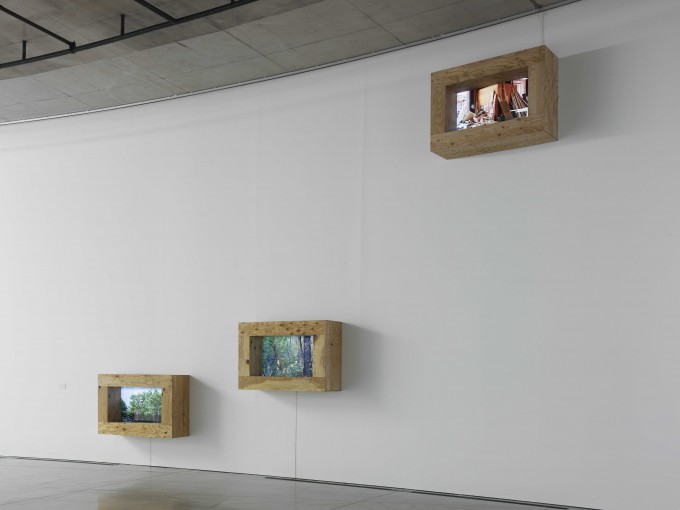
woods・forest・wood
photo: YAMAMOTO Tadasu
The Subtle Motions within Time and Space
ITO Satoko
The space that a camera can capture on video is limited by its capabilities and the lenses that are used. While you can guess the movements your subject might make within that space, once you frame your shot, all that is left to do is to hit record. At the ACAC, Jolene MOK trusted events to unfold as she peered through her viewfinder. She kept her distance and waited for something with a story to tell within the occasional chance encounter, a change in the natural environment, or any slight movement that might catch her eye. It was as if she was seeing the world for the first time through that tiny viewfinder, transported outside herself to gain an objective point of view.
For Mok, who grew up in Hong Kong, the nature of Aomori was awe-inspiring and full of new discoveries, which led her to take her camera on daily explorations of the forest that surrounds the ACAC. In the first half of her exhibition, Mok presents an installation of several videos that capture the forest in a number of forms.
Woods, Forest, Wood is a slow-paced video work in which the landscapes flow horizontally across the screen. Comprised of 360-degree shots taken in three different locations, the work and its title are a metaphoric deconstruction of the three trees (木) that make up the Chinese character for forest (森). The videos play on a never-ending loop, creating a seamless landscape where the viewer begins to lose their sense of time. Mok says that the wooden frames she placed around the video monitors (fig.1) were meant to put focus on the video itself and create a viewing experience free of the bezels that surround the televisions and computer screens we see everyday.(*1) Less traditional frames than intentional masses of plywood, their material presence seemed to collide with the images on screen. The frames had a certain depth to them, giving the work a window-like appearance. Contrary to its bulky appearance, one of the three screens floated effortlessly near the top of the gallery wall and was also visible from the stairs of the outdoor stage. Here Mok incorporated elements of the gallery's unique architecture in an attempt to show the physicality of video.
In Let Us Now Praise Forest and memento mori, Mok spliced together her digital video imagery and cut actual film from her photographs into vertical strips, illustrating the differences between film and digital expression as one point of view. Almost daily, she would shoot the same spot of the forest at different times of day in both digital and film, which she would cut into strips and and rearrange. Mok then ordered and edited her footage, weaving multiple landscapes into a singular abstract image. She removes the flow of time by mixing fragments in an attempt to focus on the visual changes that occur in a single place day by day.
Because digital video allows for recording and playback of movement, the passing of time is still clearly visible even within the thin strips Mok has cut. In her work you can see leaves swaying in the wind and rain as well as the transformation of color and light in the forest. On the other hand, the film-based memento mori is photographic, one moment of recorded time, a singular existence that cannot by reproduced or resized like a digital image. Due to the small surface area, the film was backlit and frames were installed around each piece for visitors to look into. While a photograph is captured on film as one moment in the flow of time, the film itself, as a physical object, cannot escape that flow, which will take its toll just as it does on all living creatures. The title memento mori, which is taken from the eponymous Latin phrase, calls us to remember that we will all die one day. It feels like a message that the thought of death simultaneously demands that we live in the present time. For Mok, expressing nature meant capturing it in all of its minute and subtle motions. Her artwork manifested itself as an experiment in comparing and transforming her digital and film practices by way of a treescape, which was a primary subject of her photo and video work during the residency.
Mok has traveled the world to film people and nature through her camera’s lens. She has stayed in Japan twice before to produce video works that capture the residents of downtown shopping districts and rural mountainous areas. In Stage Setting, one of her resident productions at the ACAC, Mok filmed the workshops of local Aomori artists and artisans.
She visited the factory of an indigo dyer, which transforms each day as the dyer tends to her vats of fermenting dye. Bright colors cover the workroom floor of a nebuta-shi, the professional craftsmen behind the handcrafted floats of Aomori’s annual Nebuta festival. The calm atmosphere of a lacquer workshop reveals countless processes of grinding and polishing, honed over time. A painter surrounds herself with brushes, art supplies, and books, all of which hint at the rich worldview and intellect that she instills in each canvas. The tools and equipment come alive within each space over the course of an immeasurable amount of time. One visit is not enough to fully observe the joys and sorrows of an artist or craftsman’s creative process, nor is it enough to understand the entire history of a workshop passed down through generations. Even so, Mok makes it a point to listen carefully to each person’s story and find the individual’s presence within the details of their workspaces in the short moments available before shooting. The video ends with a scene of an empty workplace where just moments before someone had been hard at work, as if to express that even in their absence, the presence of the owner has become one with the space over time.
Mok knew that changes would appear in the slight movements of her subjects’ hands and their tools. Even amid daily repetition, the human hand can never produce the same thing twice. Through her lens, she captures creation, including preparation and cleanup—moment and movement as one—a witness to the life within the refined routines of traditional artisans and artists.
Stage Setting is punctuated with a narration of sayings on art and life by famous artists, which Mok poses as questions. It could have been that for Mok, a creator in her own right, this artwork was a projection of her own image as she captured her subjects on camera. Mok did not add this narration to espouse the profound wisdom of artists who came before her but as a way to better understand herself, the answers occurring to her naturally as she watched her subjects. The spaces that exist in Stage Setting represent the space where work happens, the spatial and temporal motions of creation, and the space that exists between the subject and Mok herself.
Fig. 1: In pursuit of a siesta, video installation, 2017.
*1 Interview with the artist during residence program in October, 2018.
(translated by Queen & Co.)

Let us now praise forest
photo: Jolene MOK
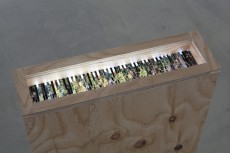
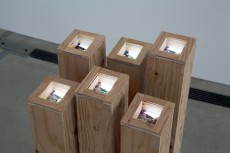
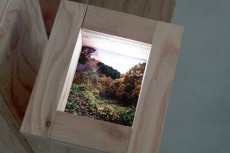
memento mori
photo: MATSUDA Masanori
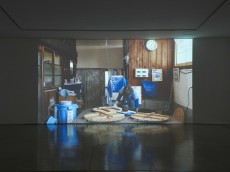
Stage Setting
photo: YAMAMOTO Tadasu

Fig. 1: In pursuit of a siesta, video installation, 2017.
〇動
2018年10月27日(土)-12月9日(日)10:00- 18:00、会期中無休、無料
ジョリーン・モク
Jolene MOK

≪林・森・木≫ woods・forest・wood
撮影:山本 糾
小さな動きにみる、時と間合い
伊藤 聡子
カメラで捕らえることのできる空間は、機能とレンズに限定される。映る対象の動きは予測できるものの、数カ所で設定される画角は一度決めると、そこでの操作は録画のオンオフのみとなる。ジョリーン・モクはその場で起きる出来事を信頼し、ファインダーを見つめる。対象に一定の距離を保ち、その時々に起こる偶然、自然の変化、目に映るすべての些細な物事の動きが伝えるなにかを待つその態度は、自己から一歩出た客観に身を置き、小さなファインダーから世界を初めて見ているかのようだった。
香港で育ったモクにとって畏敬する自然は多くの教えを得る存在であり、作家は滞在するACAC周辺の森に毎日のように通いカメラを向けた。本プログラムの展覧会では、その前半部分において様々な形で森を捉えた幾つかの映像をインスタレーションとして発表した。
《林・森・木》は、ゆっくりとした速さで風景が水平方向に流れていく映像作品だ。これは「森」という漢字のつくりを分解することで特定した3つの場所でカメラを一周させて撮影された。機械的にリピート再生させることで途切れることのない、時間の感覚を失わせるような風景となる。モクが映像モニターを額縁で覆うようになったのは[fig.1]、日常的にテレビやパソコンを見ることとは異なる体験として、再生される映像イメージだけを鑑賞するためだという(*1)。額縁というよりむしろ意図的に重厚感を持たせた木の固まりのように作られた本作のフレームは、イメージと物質の存在感を互いにぶつけているように見える。この奥行きを備えた窓辺のような作品は、その見た目に反して軽やかに高い位置へ、さらに外にある野外ステージの階段上からの視点でも見ることができるよう設置され、特徴あるギャラリーの建築要素を取り入れながら、映像を物質的に見せる試みがされた。
《森をたたえる》と《メメント・モリ》では、それぞれの媒体である映像と写真自体を切り、一つの観点として、ここではデジタルビデオとフィルムによる表現の違いを見せていた。
ほぼ毎日同じ場所で異なる日時の森の画をデジタル、フィルムで撮影し、それぞれを細長く切っては並べ替えていく。異なる材料を集めて編む、文字通り「編集」することで、切り取られた複数の風景がねじ込まれ、抽象的に一つの画面に収められた。そこでは断片を混在させることで時間の流れを排除し、同じ場所で日々起こった視覚的な移ろいに焦点をあてようとする。
デジタルビデオは動きを記録し再生することができる機能上、切られてもなお一片の画の中で時間が経過し、そこに映る雨風に揺れる葉、それらの色の変化、光、といった流れを見せた。一方、写真フィルムを素材とする《メメント・モリ》は、記録できる時間は一瞬であり、また、デジタル映像のように複製したりサイズを変えて再生したりすることのできない唯一の存在だ。フィルムの画面は小さく、光をあてて覗き込むためのフレームが設えられた。焼き付けられた場面をその本体にとどめるが、フィルムは物質としての時間による変化を免れない。生き物と同じように時間を刻みながら並んでいた。タイトルに用いられた古いラテン語の「メメント・モリ」は「死を忘れるな」という意であり、死の存在を憶うことが同時に、生きている現在の時間を想うことだというメッセージを、切り刻まれた写真によって伝えている。モクにとって自然をとらえて表すことは、自然が携える小さく些細な時の変化/時間、つまり動きを捕らえることだった。デジタル、フィルム、撮影対象となった木のある風景、それぞれを変化させ比較する実験的な試みが作品として表われた。
これまでも自然や異なる地域、国の人々の暮らしをカメラに収めてきたモクは、日本には二度滞在し、街の商店街や山間に住む人たちに目を向けて映像作品を制作してきた。今回、青森では県内の伝統工芸士、染師、美術家のご厚意により、彼らの仕事場を撮影させていただけることになった。
日々変化する発酵具合によって長い間手が加えられてきた藍甕が並ぶ染工場。畳一面に鮮やかな色彩が広げられるねぶた絵師の仕事場。たくさんの工程に合わせて構成され、穏やかさと研ぎ澄まされた時間のある漆工房。豊かな人生観と知性をキャンバスに落とし込む美術家の部屋は、多くの筆や画材、書物に囲まれる。それぞれそこで使われる道具や設備が、測ることのできない時間のうちに出来上がった空間に息づいている。一時的に訪れたところで、代々受け継がれてきた工房の歴史や、美術家や絵師の試行錯誤と苦楽といった過去を目にすることができるわけではないが、刻まれてきた時間を空間の中に捕らえようと、モクは撮影前の短い間に話を聞き仕事場の背景をできるだけ観察した。それらは、映像作品の最後でそれぞれの制作する場面から切り替えられる誰もいない仕事場の場面によって、空間に一体となっていた主の存在と、それまで繰り返されてきた長い時間、年月として表われていたのではないか。
その中でもモクは、繰り返される手や物の中に、変化となる小さな動きが現れることを知っていた。毎日のように繰り返されてきた作業であっても、人の手によって同じものは生まれない。制作のための準備と片付けをも含め、ものが作り出される時間/動きをカメラ越しに見続けたその映像には、伝統工芸士、染師、美術家が持つ反復する規律正しい動きとしてそれぞれの息づかいと時間の流れ、リズムが現われていた。
また、映像に流れるナレーションでは、著名な芸術家達の格言を元に芸術と人生を問うた。自身もまた制作をするモクはカメラを構えながら、何かを作り出すことに自分自身を投影していたのかもしれない。人生/芸術の道を歩んだ先輩の格言は、教えを得るためではなく、作品が作り出される時間を目にしながら自ずと心に浮かんでくる答えによって自身を知るための言葉なのだろう。《間合いを取る》にある間は、仕事場の空間であり、ものが作られる時間/動きであり、またそれらに向き合うモク自身との間隔を表わしていた。
(*1)滞在制作中の聞き取りでの発言(2018年10月)
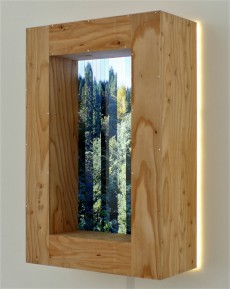
≪森をたたえる≫ Let us now praise forest
撮影:ジョリーン・モク
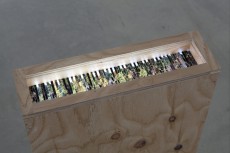
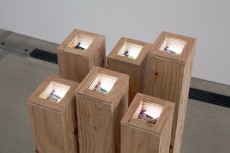
≪メメント・モリ≫ memento mori
撮影:松田 壯統

≪間合いを取る≫ stage setting
撮影:山本 糾
